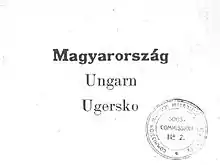Sopron plebiscite
The Sopron plebiscite took place on December 14-16, 1921. In this plebiscite, the residents of an area of 257 km2, comprising Sopron and eight surrounding settlements, voted on whether to remain in Hungary or to join Austria. That was the only plebiscite about the disputed borders on the territory of the former Kingdom of Hungary after the World War I, which was allowed by the Entente.[1]

Participant settlements
The following settlements participated in the plebiscite. The Hungarian names are given, with their German counterparts in brackets:
- Ágfalva (Agendorf)
- Balf (Wolfs)
- Fertőboz (Holling)
- Fertőrákos (Kroisbach)
- Harka (Harkau)
- Kópháza (Kohlnhof)
- Nagycenk (Zinkendorf)
- Sopron (Ödenburg)
- Sopronbánfalva (Wandorf)
Results
26,879 people were eligible to vote in the plebiscite. 24,063 of them voted. 15,534 voted for Hungary, while 8,227 voted for Austria. 502 ballots were invalid.
18,904 residents of Sopron had the right to vote in the plebiscite. (At the time of the plebiscite Sopron had 37,509 residents.) Here, with a turnout of 89.2%, a large majority (72.7%) voted for Hungary. However, in the 8 villages, the support for Austria was greater, with 5 villages voting for Austria. Only Nagycenk, Fertőboz and Kópháza voted for Hungary.
| Settlement | Eligible voters |
Total votes | Invalid | For Austria | % | For Hungary | % |
|---|---|---|---|---|---|---|---|
| Sopron / Brennbergbánya | 18,994 | 17,298 | 351 | 4,620 | 27.2 | 12,327 | 72.8 |
| Ágfalva | 1,148 | 848 | 18 | 682 | 82.2 | 148 | 17.8 |
| Harka | 668 | 581 | 9 | 517 | 90.4 | 55 | 9.6 |
| Fertőboz | 349 | 342 | 11 | 74 | 22.3 | 257 | 77.7 |
| Kópháza | 948 | 813 | 30 | 243 | 30.0 | 550 | 70.0 |
| Fertőrákos | 1,525 | 1,370 | 33 | 812 | 60.7 | 525 | 39.3 |
| Sopronbánfalva | 1,538 | 1,177 | 35 | 925 | 81.0 | 217 | 19.0 |
| Balf | 668 | 595 | 17 | 349 | 60.4 | 229 | 39.6 |
| Nagycenk | 1,041 | 1,039 | 8 | 5 | 0.5 | 1,026 | 99.5 |
| Total[2] | 26,879 | 24,063 | 512 | 8,227 | 34.9 | 15,334 | 65.1 |
References
- Irredentist and National Questions in Central Europe, 1913-1939: Hungary, 2v, Volume 5, Part 1 of Irredentist and National Questions in Central Europe, 1913-1939 Seeds of conflict. Kraus Reprint. 1973. p. 69.
- Zahlen nach: Oskar Helmer: 40 Jahre Burgenland. Ein Land wählt die Freiheit. Wiener Volksbuchhandlung, Wien 1961, S. 50.